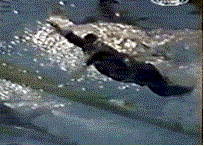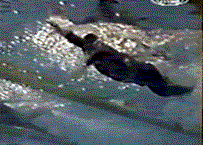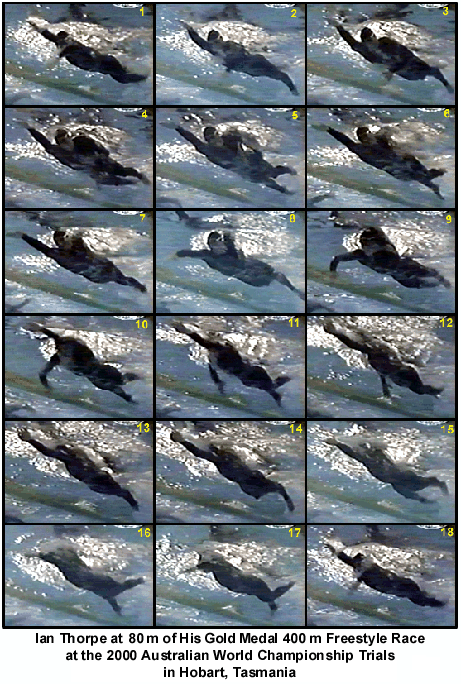HOW CHAMPIONS DO IT
Researched, produced, and prepared by Brent S. Rushall,
Ph.D., R.Psy.

IAN THORPE AT 80 m OF HIS GOLD MEDAL 400 m FREESTYLE RACE AT THE 2000 AUSTRALIAN WORLD CHAMPIONSHIP TRIALS IN HOBART, TASMANIA
This stroke analysis includes a moving sequence in real time, a moving sequence where each frame is displayed for .5 of a second, and still frames.
The following image sequence is in real time. It will play through 10 times and then stop. To repeat the sequence, click the browser's "refresh" or "reload" button.

The following image sequence shows each frame for half a second. It will play through 10 times and then stop. To repeat the sequence, click the browser's "refresh" or "reload" button.

At the end of the following narrative, each frame is illustrated in detail in a sequential collage.
Each frame is .1 seconds apart. Ian Thorpe's time in this race was 3:40.76, just outside his world record.
Notable Features
This perspective shows Ian Thorpe's execution of "elbow-up" positions in both arms. That position provides a propelling surface consisting mainly of the forearm and hand, although the lower portion of the upper arm also provides propulsion in the middle of the propulsive phase. It appears that the length of effective pull, that is, the time when propulsion capable of accelerating the swimmer is effected, is slightly longer for the left arm than the right.
The directness of the swimmer's pulling actions is noteworthy. The hands sweep almost horizontally throughout the phase of effective propulsion. Such directness is likely to produce efficient swimming, much in the manner of Kieren Perkins in the first half of the 1990s. With little wasted effort, that is, force components created in unnecessary directions, a near maximum effect could be achieved.
The swimmer demonstrates excellent streamline.
While the recovered arm remains forward until the propelling arm completes its pull, and thus gives the impression of a gliding action, there appears to be an inertial lag between pull completion and the commencement of the pull in the recovered arm. The swimmer's kicking action is more pronounced in this sequence than in previous analyses. One has to wonder if the increased inertial lag is due to the swimmer's excessive concentration on a six-beat kick. Could it be that the press coverage of his kick, which adds little to propulsion in this stroke, has influenced the stroke?

Return to Table of Contents for this section.






